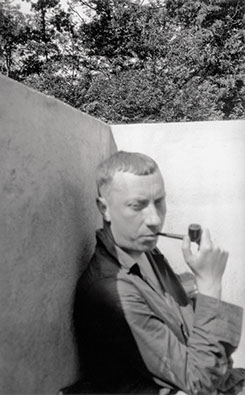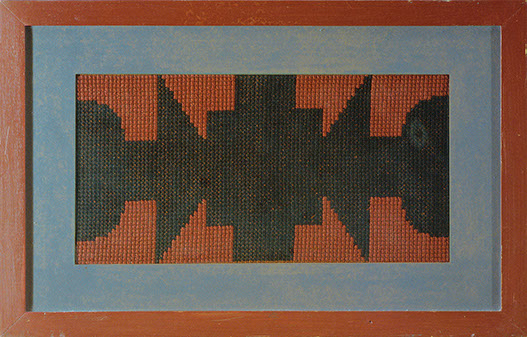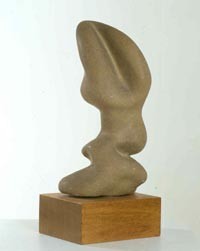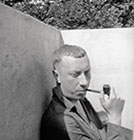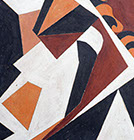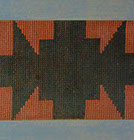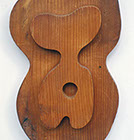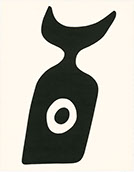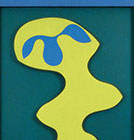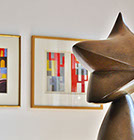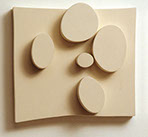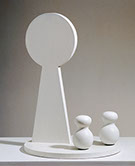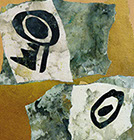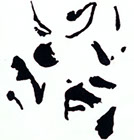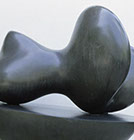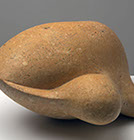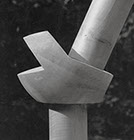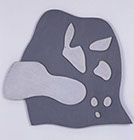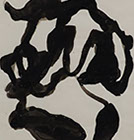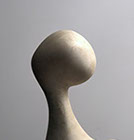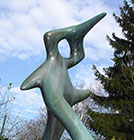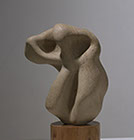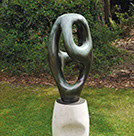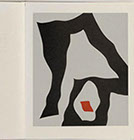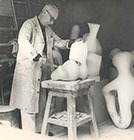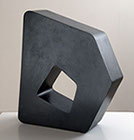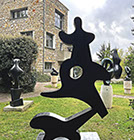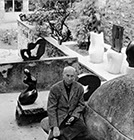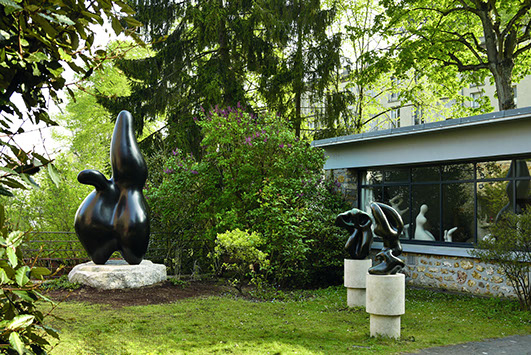
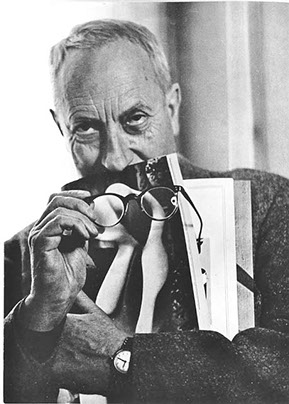
jean arp
Arp used to say that the violin could tame the clouds, have them bask from the happiness on earth. Than, they would let themselves be petrified. Arp tossed his fishnets very high and very far, from the navel to the star, from the moustache to the clouds, from the smile to the water drop which trembles on a cob web, from the torrent pebble to the rainbow. He captured the analogies. He thus broke our categories, our organizations. He was thus revealing the relations between the mineral, the animal, the vegetable. He realized impossible matings where a bacteria starting having a nose and the universe in its entirety, new possibilities. We were finally the threads of the stars, the brothers of wheat, of granite, of water vapour. The Big-Bang had not ended.
Pierre Descargues - 1992
biography
1886
Born in Strasbourg in 1886, of an Alsacien mother
and a German father, Jean (Hans) Arp spends his first twenty years of his life between Strasbourg and Weggis,
next to Lucerne, interrupted by stays in Paris,
Weimar and Berlin.
He maintains very early intense contacts with artists
which seek to dissociate themselves from traditionnal forms of art.
1910
He set up with his friend Walter Helbig,
"Der Moderne Bund". In 1912, he meets Kandinsky.
"In his studio, speech, form and colour were blending
and transforming themselves into fabulous, unheard
of, never before seen worlds". Arp collaborates
with the « Blaue Reiter » yearbook and exhibits together with the Delaunay couple, Le Fauconnier, Franz Marc
and Paul Klee.
Arp publishes his first poems, puts drawings, collages,
on exhibit, illustrates publications. Expressing himself
in German as in French, he plays with words as much
as with shapes, in an interaction which he won’t cease
to pursue throughout all his life.
1914
Jean (Hans) Arp and his brother François (Wilhem) move to Paris to run away from German mobilization.
In 1915, Arp takes refuge in Zurich where he meets Sophie Taeuber.
Beside Hugo Ball, Richard Huelsenbeck, Tristan Tzara, Marcel Janco, Hans Richter, he participates in 1916
in the foundation of the “Cabaret Voltaire”. That’s where the Dada movement will be born. Conferences, recitals, spontaneous music and later, simultaneous poems celebrate nonsense. The artists express their revolt against the bourgeois order, the war massacres
and the academic aesthetic. Art is used as an instrument of subversion to transform life, to fight men’s foolishness and to reconcile them with the natural order. Arp starts working on his reliefs.
1916
Arp draws his inspiration from the laws of chance, banishing the will in the composing process. He is guided by two imperatives: art must be concrete and follow nature’s spontaneous and peaceful processes as subject. The union of both will give birth to the « Earthly shapes », reliefs, drawings, etchings, echoing a nature with meaning, the logic of which is not man’s logic and which becomes the guiding principle of all his work.
After the first world war, the dadaist impulse spreads throughout Europe. In the twenties, Arp takes part
in the movement, in Germany, where dadaists
(Hausmann, Schwitters et Tzara) and constructivists
(Van Doesburg, El Lissitzky, Moholy-Nagy) meet, in Paris where he meets up Tzara and Picabia and links up
with literary spheres which gravitate around André Breton, Philippe Soupault, Georges Ribemont-Dessaignes
and Louis Aragon.
1922
On October 20th, he marries Sophie Taeuber,
in the Tessin canton.
1925
Arp settles down in Paris in 1925, while the first surrealist exhibition was taking place in Pierre Loeb’s gallery,
after having tried in vain to get naturalized in Switzerland, where he is considered to be unwelcome given his Dada actions. He obtains the French nationality in 1926,
at the same time as his wife Sophie Taeuber-Arp
and his brother François.
It’s in the twenties that Jean Arp invents his "arpadian encyclopedia”. His organic shapes turn to objects :
the clock, the navel, the moustaches, the hat, the tie,
the bottle, the sismic plant, the eagle, and so many more. Combining several images within an identical « relief »,
he uses his famous humour to upset nature’s usual hierarchy, to make fun of human claims and to establish
a parity between man and the inanimate object.
1926
Alongside their activities in Paris and Zurich, the couple regularly stayed in Strasbourg, where they had to reside in order to obtain French nationality (Sophie Taeuber-Arp, Jean Arp and his brother François were naturalised French citizens on 20 July 1926). That same year, the couple received the commission for the renovation of the Aubette in Strasbourg. They undertook the project with the help of Theo van Doesburg. The three artists produced a collective work without equivalent in 20th century art.
1927
His first personal exhibition is being organized
at the Galerie Surréaliste, the catalogue is prefaced
by André Breton. His affinities with André Breton’s group express themselves in the "reliefs" and in the poetry
which the surrealists, in particular Marcel Jean, who will become one of his best friends, prompt him to make use
of to explore his plastic work. Arp, loyal to Dada, keeps however his guard up, notably vis-à-vis its rejection
of abstract art, its political stands or its internal quarrels.
1929
The Arp couple can settle down in Meudon-Clamart,
in a studio house built according to plans by Sophie, thanks to the fees received for the Aubette workings in Strasbourg, which they carry out with Theo van Doesburg.
The same year, Arp joined, together with Taeuber-Arp,
the "Cercle et Carré", a movement favouring pure abstraction, founded by Michel Seuphor and Joaquín Torres García. In 1931, he joins "Abstraction Creation", founded by van Doesburg, a movement to which Herbin, Kupka, Calder, Mondrian, Schwitters, Hélion,
Sonia and Robert Delaunay participate.
1930
The early stages of the thirties is a period of intense creative activity. Arp addresses sculpture in the round, transposing his reliefs in three dimensions,
in a condensation, petrification process (“Human concretions"). He invents collages made from ripped up paper, stemming from his own paper works,
the "Constellations" or "Configurations", compositions
just like nature which constellates and re-constellates permanently.
Arp is more and more approached for exhibitions
(Jeanne Bucher and Goemans galleries in Paris, galleries in Brussels, Zurich, Berne, New-York, San Francisco). Critics apply themselves to make known his work, notably Carola Giedon-Welker in Zurich. Several collectors
in Switzerland and in the United States buy regularly works from him, as well as from Sophie Taeuber-Arp. Among them appears Marguerite Hagenbach whom he meets in 1932.
1940
Driven by war, Arp and Sophie Taeuber-Arp find themselves in Grasse in Magnelli’s home, where Sonia Delaunay meets up with them – it’s the timeperiod
where the four artists, rediscovering the dada practices, create jointly drawings and gouache paintings. Not having been able to obtain visas to enter the United-States,
Jean Arp and Sophie Taeuber-Arp take refuge in Switzerland, in Max Bill’s home, where Sophie will die accidentally in January 1943.
1945
After the war, Arp comes back to Clamart-Meudon,
sharing his time between writing, the reliefs, the drawings, the collages, sculpture. He enjoys now the support
of several galleries (Denise René, Pierre & Edouard Loeb and Maeght in Paris, Susie Feigel in Basel, Kurt Valentin, Sidney Janis, Arthur and Madeleine Lejwa of the Chalette gallery in New-York, Max Stern in Montreal).
1950
During this period, Arp travels a lot. He plans at a time
to take up residence in New-York, considering that
not enough interest is shown for his work in France.
At the request of Walter Gropius, he creates
a monumental relief for the Harvard Graduate Center refectory.
1953
Carlos Villanueva, architect the new Caracas University, asks him for his first monumental bronze sculpture, the "Berger des Nuages" ("Shepherd of Clouds").
1954
The sculpture Grand prix of the Venice Bienniale,
which he won this year, gave him recognition
and the affluence which he had lacked until then. He can call on assistants and meet an increasingly plentiful demand for the bronze editions of his works in plaster, which, for lack of money, he had not been able to create until then. He invents the “Thresholds", going back
to his first sculptures of the twenties, he diversifies
the materials used, produces enlargments, notably
on the occasion of monumental works in France,
in Switzerland, in the United-States, in Germany,
in the Netherlands.
1958
The Museum of Modern Art in New York devotes to
him a personal exhibition. Arp travels for the first time
to Mexico.
1959
On May 14th, he marries Marguerite Hagenbach, a Swiss collector he met in 1932, which shares his life since
the end of the war. Arp takes up residence in Basel
where Marguerite has an appartement, Clamart becoming their second home. Mrs Arp-Hagenbach buys moreover,
in Solduno, near Locarno in the Tessin canton, a property (today, home of the Fondazione Marguerite Arp) where
the couple will be staying more and more frequently.
1962
The Musée National d'Art Moderne in Paris organizes
him a retrospective, which will travel to Basel, Stockholm, Copenhaguen and London.
Over these years, a greater part of his work
is dedicated to monumental enlargements.
1966
Arp dies in Basel on June 7th, leaving in the Clamart-Meudon studios an extensive suit of works. Beforehand, he had the time, with the help of Marcel Jean, to gather a large part of his writings in French, from 1920 to 1965. They were published after his death, in 1966, by the editor Gallimard.
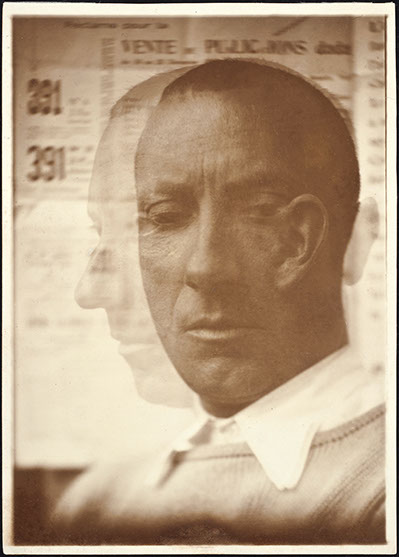
El Lissitzky, portrait of Jean Arp, 1924
dada is in favour of the absence of meaning,
which doesn’t mean being deprived of meaning.
dada is without meaning, as nature.
dada is in favour of nature and against "art".
dada is direct, as nature,
and seeks to give to each object its essential place.
dada is in favour of the infinite meaning
and the defined means.
Jean Arp, 1927, in Jours Effeuillés
We don’t want to copy nature.
We don’t want to duplicate, we want to produce.
We want to produce like a plant which produces
a fruit and not reproduce.
We want to produce directly
and not through outside intervention.
As there is not the slightest trace of abstraction
in that art, we name it: concrete art.
Jean Arp, 1944, in Jours Effeuillés
I ment to find a different order, an other value of man within nature. He was not to be any longer
the measure of all things, nor relate everything
to his scale, but on the contrary, all things and man
had to be like nature, without scale.
I wanted to create new appearances, extract
new shapes from man.
Jean Arp, 1948, in Jours Effeuillés
Man calls abstract what is concrete.
This is not surprising, because he usually confuses
the front and the back while using his nose, mouth
and ears, that is to say five of his nine openings.
I understand that we call a cubist painting abstract, because parts have been subtracted from the object
that served as the model for that painting. But I find
that a painting or a sculpture that have not had
an object for model, are just as concrete and sensual
as a sheet or a stone.
Jean Arp, 1948, in Jours Effeuillés

